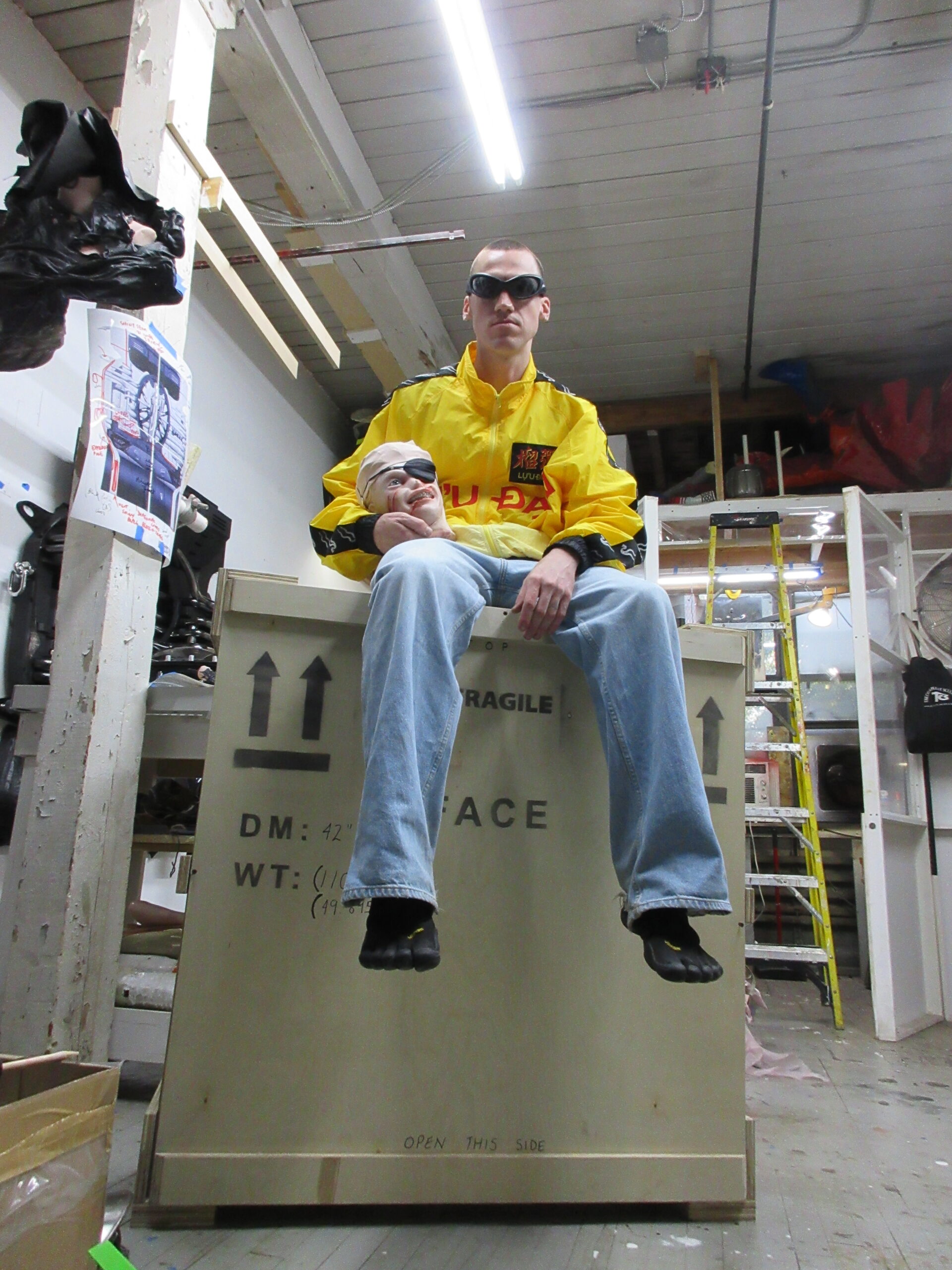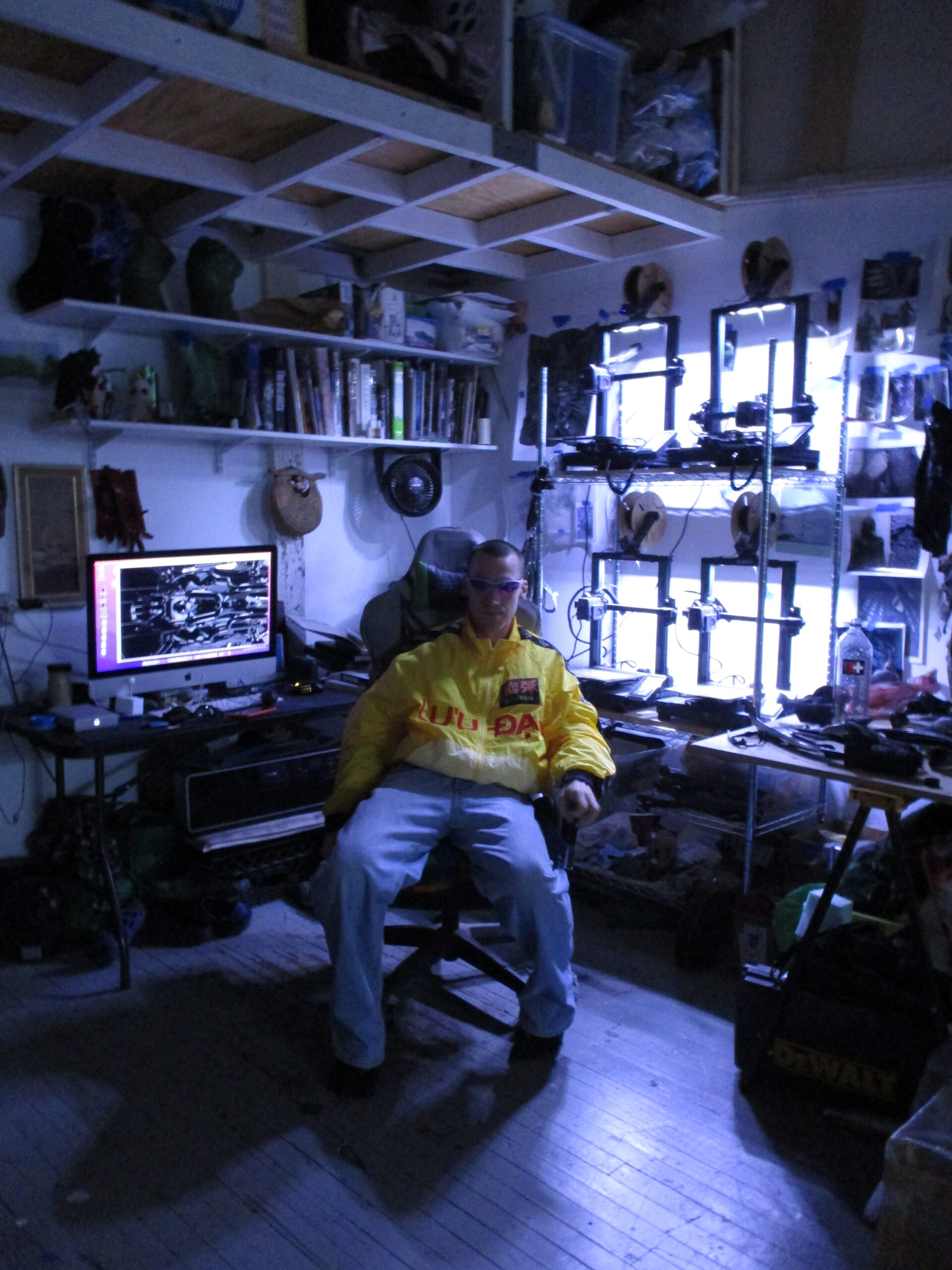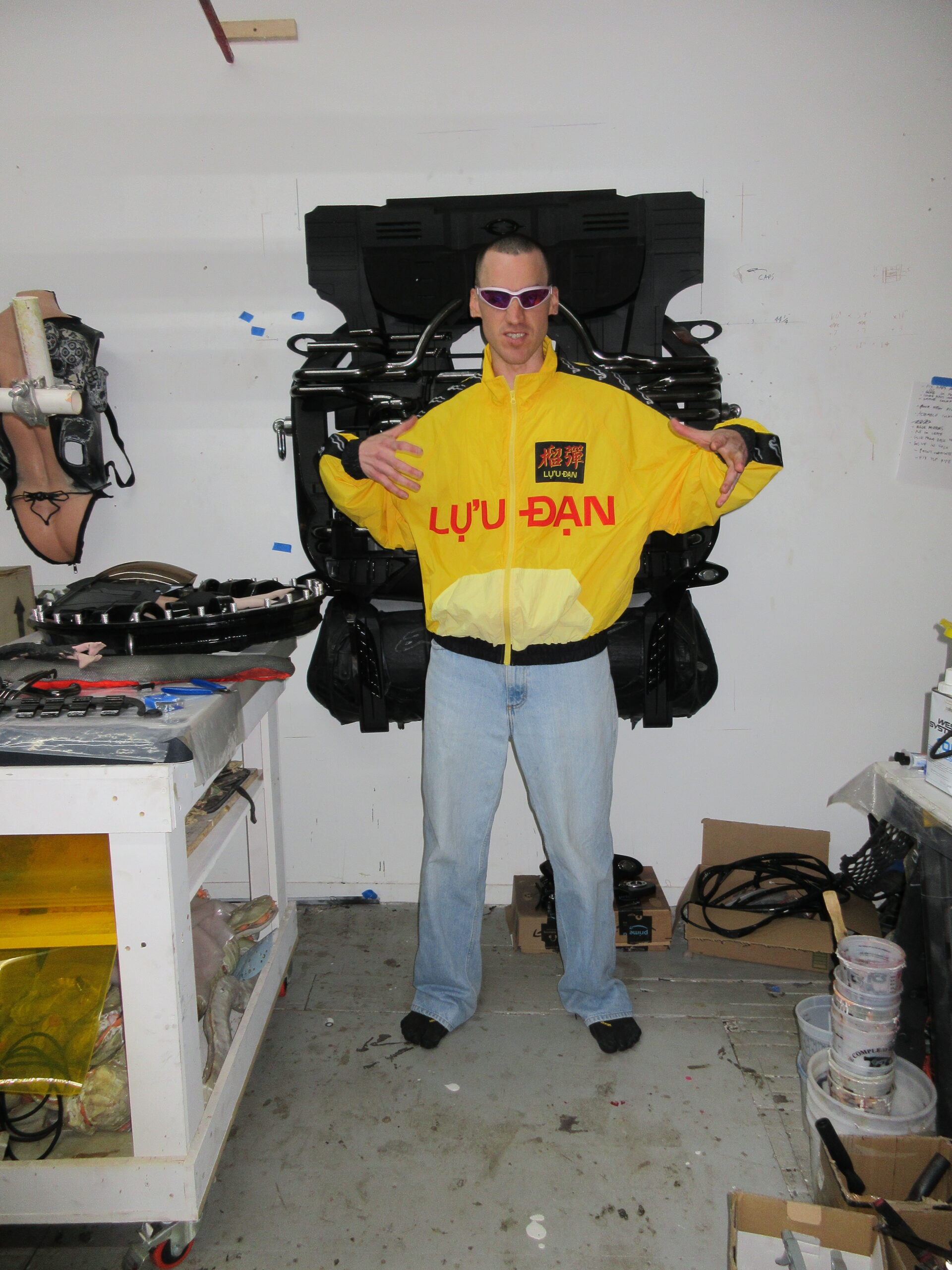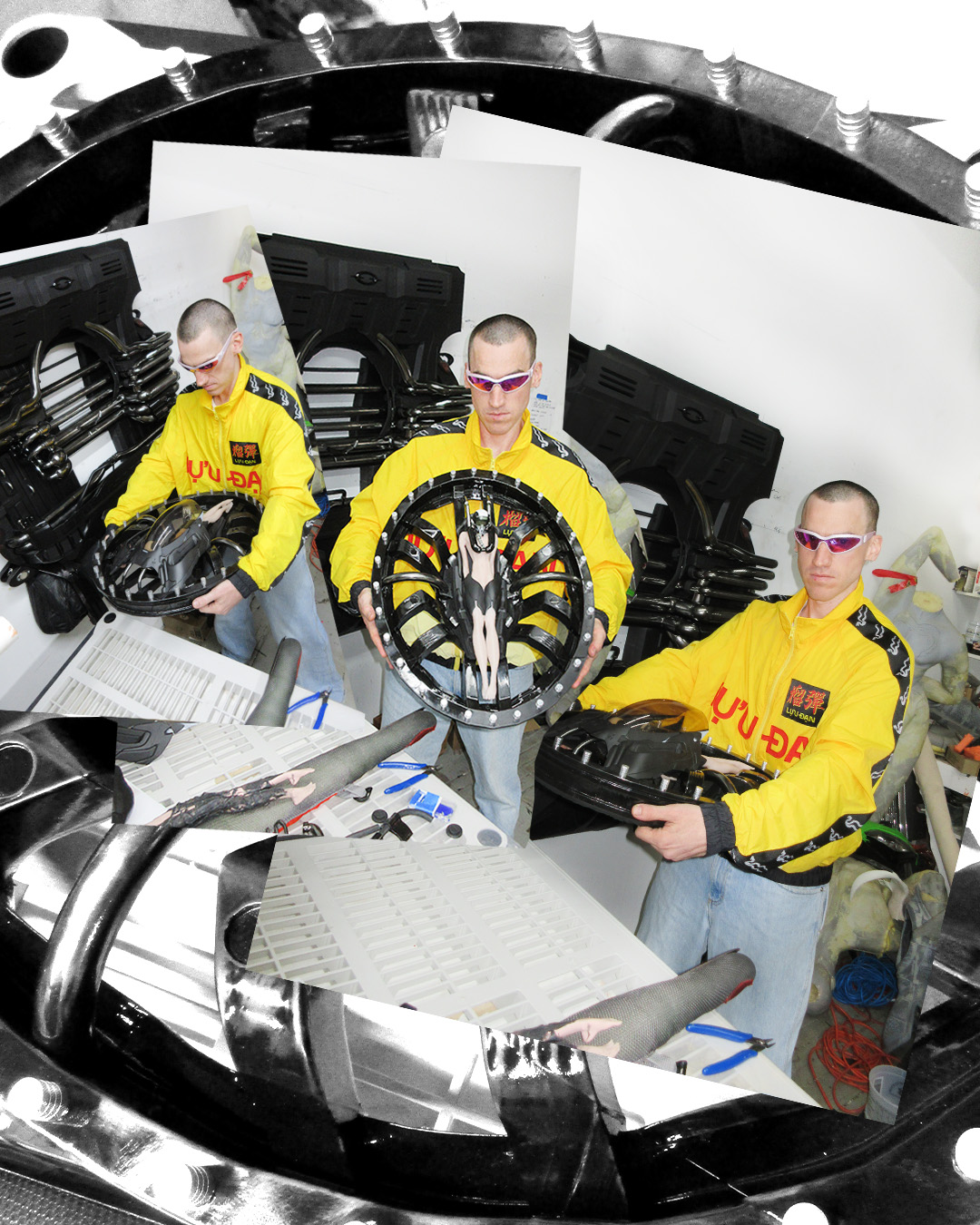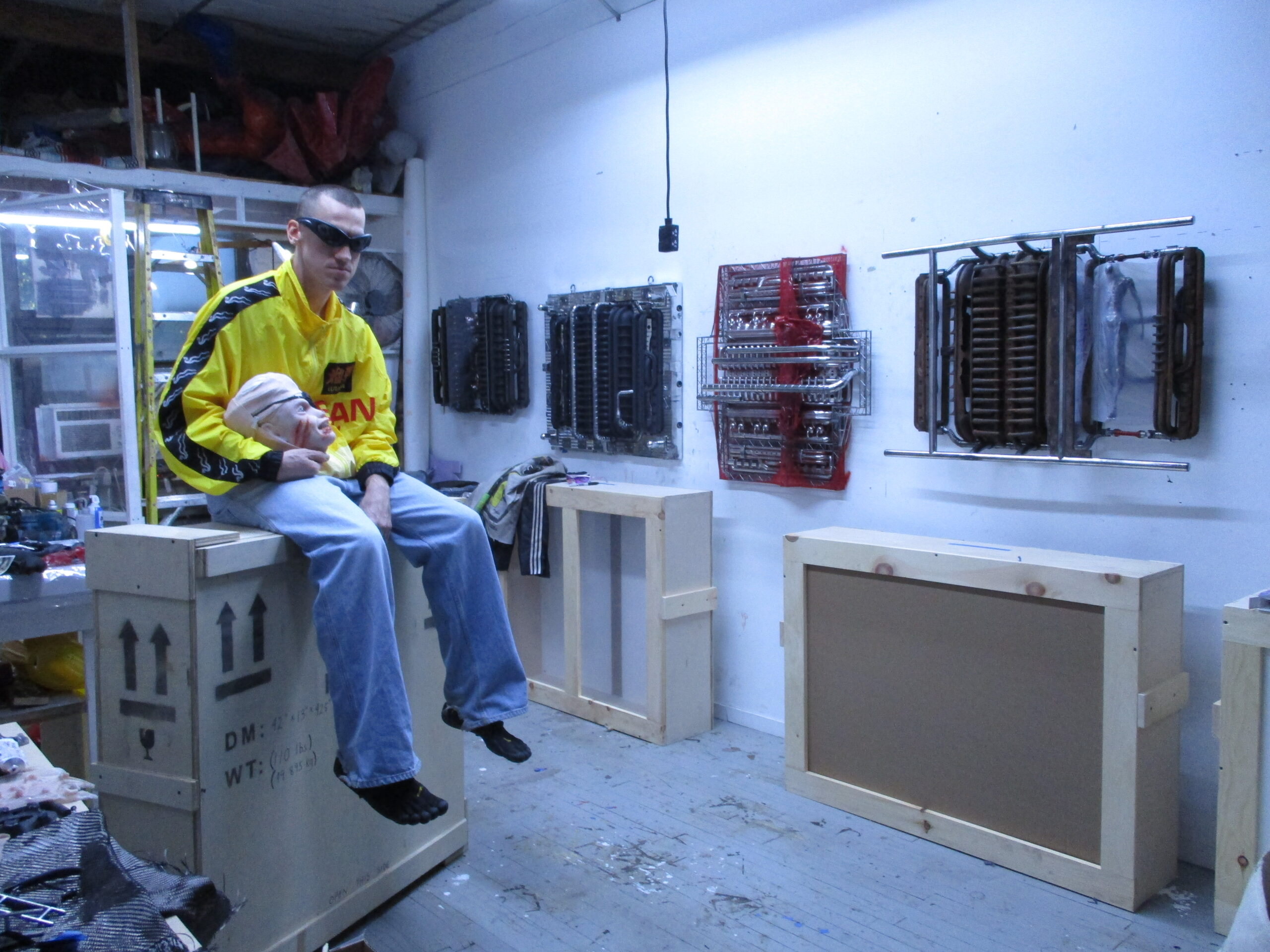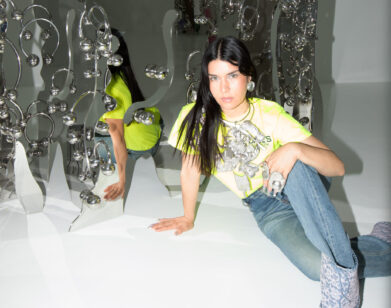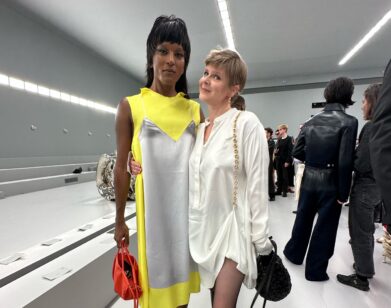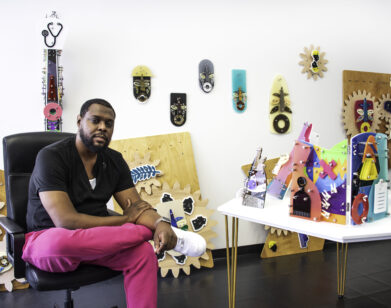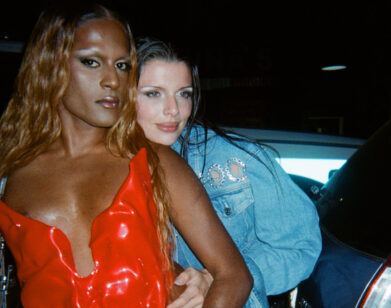STUDIO VISIT
Taylor Ashby Hawkins Shows Richie Shazam the Innards of His Sculptures
Taylor Ashby Hawkins wants his work to feel like a slow-mo motorcycle crash: terrifying, but beautiful. The Kentucky-born, New York-based artist’s solo show ENDO opens this week at Ashes/Ashes, where his sculptural works marry anatomy and machine, evoking what the artist calls “Cronenberg-y” body horror. “It’s all plastic,” explains Hawkins while giving fellow artist and photographer Richie Shazam a tour of his Ridgewood studio. “It’s all made with the potential of being the real thing.” Hawkins refers to his works as “prototypes”—not just constructed from the man-made, 3D-printed materials that dominate his YouTube search history, but infusing them thereafter with the history of human design, the externalization of our innards, like the metallic intestines of the Pompidou. Just before the opening of ENDO, Shazam asked Hawkins to explain his many sources of inspiration, from “Dragon Skin” silicone to Dune.—JULIETTE JEFFERS
———
RICHIE SHAZAM: Hi, Interview. It’s Richie Shazam reporting live. So, Taylor, where are we?
TAYLOR ASHBY HAWKINS: We are in Ridgewood, off the L Jefferson stop.
SHAZAM: We are deep in Ridgewood at Taylor’s studio, in the midst of some really incredible sculptures. But before we get into these sculptures, what was the last thing you watched on YouTube?
HAWKINS: I was probably watching some YouTube video on carbon fiber. They usually use it to reinforce cars or planes. It’s a shell to stiffen the surface. I’m just obsessed right now.
SHAZAM: And have you used it before?
HAWKINS: I haven’t yet, but it’s all around the studio right here.
SHAZAM: Incredible.
HAWKINS: You cover it in resin, then it gets all shiny and you have to sand it. I think it’s the whole process that I love doing.
SHAZAM: I am very into the fantasy of where you go to find inspiration. Can you walk us through your general inspirations?
HAWKINS: I think the past has been more specific to the body. But with this series, I was trying to leave the body and focus more on architecture, a kind of architecture still related to the body, like Beaux-Arts. It takes the ducts and sewage pipes and vents and puts it on the exterior to maximize what’s in the interior. The buildings I’m thinking of: Lloyd’s of London. You have The Pompidou. I’m kind of taking those constructions, a way of building, and relating that to the body.
SHAZAM: Definitely. I feel like there is a strong language of anatomy, interiors and exteriors. Being one of the first people to see your newer work, it does seem like it’s going into the guts.
HAWKINS: Yeah, the innards. Also living in the city, there’s always some sort of construction. You have the fabric that covers the buildings. Fashion, you think of adorning yourself with some sort of garment. I started thinking about architecture in that certain way—of what to put on a building or how the building relates to the body. And then, New York City as a whole macro thing.
SHAZAM: New York City is the ultimate landscape to draw inspiration. How long have you been here?
HAWKINS: I’ve been in New York since 2013.
SHAZAM: How did you land here?
HAWKINS: Gosh, I don’t know. I was born in Kentucky and went to school in Ohio. I knew I wanted to be in New York City. To get here, I had to go back to Kentucky and start serving. I was probably the worst server ever. They would have cut me first, but I got enough tips to get here.
SHAZAM: What was your first idea as to why you wanted to come to New York?
HAWKINS: The artists I was attracted to were here—some were overseas in Berlin, but I knew I wasn’t going to quite make it to Berlin. New York City seemed possible.
SHAZAM: Absolutely. And you went to school in New York?
HAWKINS: Yes. After being here for a couple years, I went to Columbia. I got into the sculpture graduate program, but, during my time there, I studied performance. I was trying to make these videos and create an immersive experience that multiple people could be a part of.
SHAZAM: Incredible. And so, being in New York for over 10 years, what do you think has been the thread that keeps you here and informs your work?
HAWKINS: I was thinking about this the other day. The city is something that drives us crazy maybe, but if we leave, we would want it back. I’m building these machines that carry this body, but I feel like both the body and the machine need each other. Compositionally, they feed on each other. And like New York City, I think there’s this romantic way of looking at that.
SHAZAM: Well, New York is a car crash. It’s a spectacle that draws people in. How do you gain your stripes? Surviving the car crash. And there is an auto body shop element that I’m feeling– but also elements of rest, decay, something quite sanctified because you have these figures. What are they made out of?
HAWKINS: The figures are silicone. I think this particular material is called “Dragon Skin.” You mentioned car crashes, and another word that I thought of was “wonderific”—something that is terrifying yet beautiful. Like speed racing, when the motorcycle crashes in slow-mo, and this body is turning and flopping over. There’s something beautiful about the body. But it’s terrifying.
SHAZAM: It’s a jarring experience of losing control. You are out of your body, out of your mind. But when you slow it down, there is something quite beautiful.
HAWKINS: Yeah. These prototypes are supposed to animate themselves. As you go through the show, I wanted an experience where the works reveal their function. They reveal a figure as they extrude, and what they’re doing to that figure is showing how it’s constrained.
SHAZAM: On first glance, what’s really awesome is that there’s such a vast array of materials.
HAWKINS: I call them prototypes because when you think of shoe design, they have to come to the table with different ways to make it. These are all 3-D printed, so it’s all kind of the same material. What’s aluminum is not actually aluminum. It’s 3-D printed, and then I did a silver faux-metallic finish. The rust is not actually rusted metal– it’s 3-D printed that I did a patina on. It’s all plastic. It’s all made with the potential of being the real thing.
SHAZAM: That’s actually insane. My eyes were totally fooled. And that speaks to the incredible craftsmanship in the prototypes. Also, experiencing your older works, I get “gamer paradise.” Can you brief us on the fantasy of your previous works?
HAWKINS: Yeah. I feel like my previous works are more centered around video game culture. I was trying to find this immersive virtual experience. Now, I think about it as just a potential—what could be.
SHAZAM: What’s your sign?
HAWKINS: Aries, but on the cusp of Pisces.
SHAZAM: Emotional, but freethinker.
HAWKINS: Yeah.
SHAZAM: Making an educated guess, I think you’re constantly drawn by new things. You’re quite porous, you’re taking things in and trying to see them in different ways. Because there’s something quite brainiac about your work—it’s highly intelligent. Let’s actually break down the details. There’s the beauty of your brain, but also your hands because you’re a composer of materials. But how does fantasy play into that? Do you think your work is self-reflective, or just imagery of things in your fantasy land?
HAWKINS: Probably both. I try to make work that we can all relate to, so maybe it’s what we all feel.
SHAZAM: Well, there’s definitely sensory explosion and exploration. I think now more than ever, with all the intensity in the world, we’re drawn by fantasy.
HAWKINS: It’s fantasy, but it’s also juggling this interest in how to make that sort of thing. I wanted to know more about silicone, so I did a lot of work with silicone trials in my last shows. Looking at prosthetics, again. I feel like all these worlds are bifurcating. Music, film, prosthetics, sculpture—they’re all kind of using one another. And I think that’s a good potential space to be creating work.
SHAZAM: Absolutely. And it’s happening quite organically.
HAWKINS: It’s probably social media.
SHAZAM: What’s rad about your work, too, is that it’s so new and fresh in a sea of things being referential. I’m obviously obsessed with anything about anatomy and bodily autonomy. And I think your new prototypes step into that even more.
HAWKINS: Yeah. I’m starting this new series right now and am thinking about [David] Cronenberg and one of Charlie Chaplin’s films, Modern Times. The factory scene, where it’s about the burden of repetition in modern existence and then having a body within that.
SHAZAM: Is the body trapped, or can the body get out?
HAWKINS: It’s your read.
SHAZAM: Yeah.
HAWKINS: This one specific prototype is kind of Cronenberg-y. It feels like skin stretched over a body that’s going to shape-shift. But then sculpturally, I had to think about material; I couldn’t stretch it too much because then it’d rip. So it’s kind of finessed and a little bit delicate.
SHAZAM: The sci-fi element of it is so spot on.
HAWKINS: Yeah. I mentioned Chaplin’s factory film, but from recent films, you’ve got Dune. The set designers, the certain mood or attitude they want to express within that shot. There’s a certain interior behind them. I’m attracted to that dramatic, dark, Gothic attitude.
SHAZAM: Well, I think you’re digging deeper to really unearth it.
HAWKINS: But these forms, too, are just everyday. The objects that I’m so attracted to are there in front of me. While I was making this work, there was a new elevator shaft being built just off the F train. It’s been behind those blue painted plywood doors they put up. But as I’m finishing this series, the elevator is unveiled, and it’s like a glass cage. And I feel that’s exactly what I was trying to make—this container that’s mobilizing another body. Subconsciously, it’s going to reappear in the studio.


